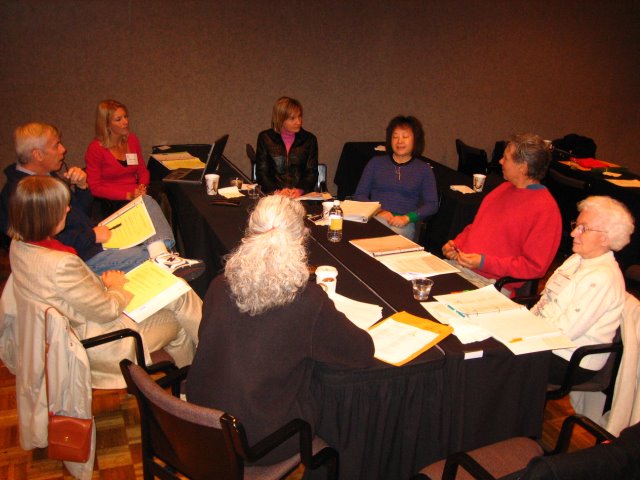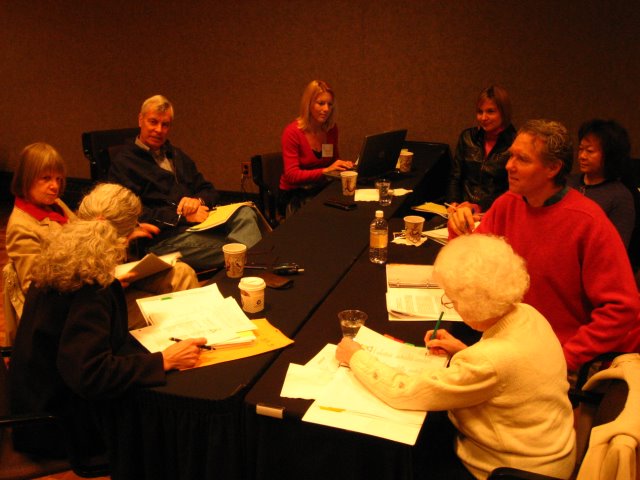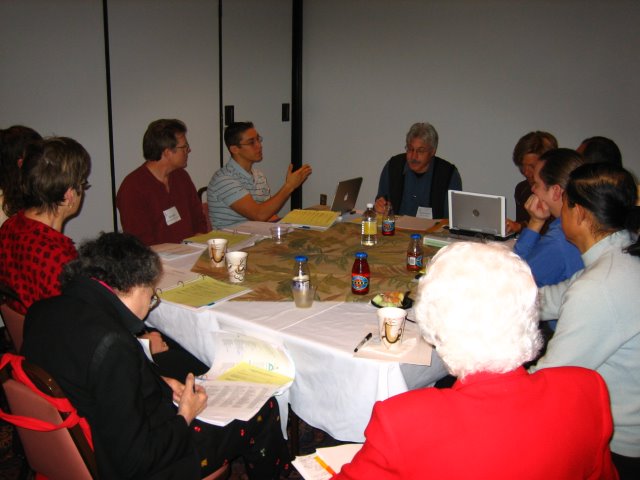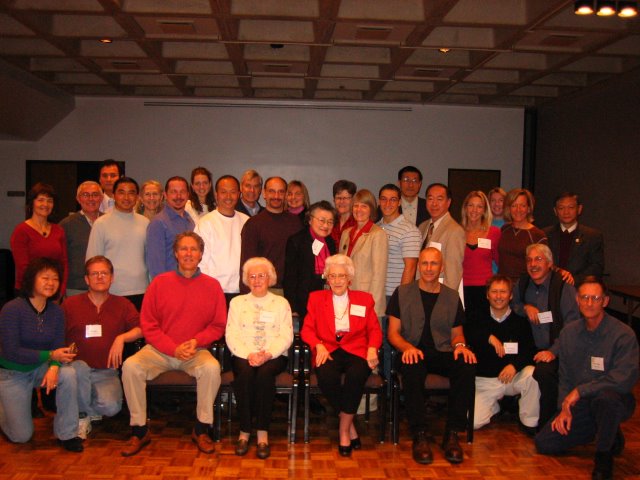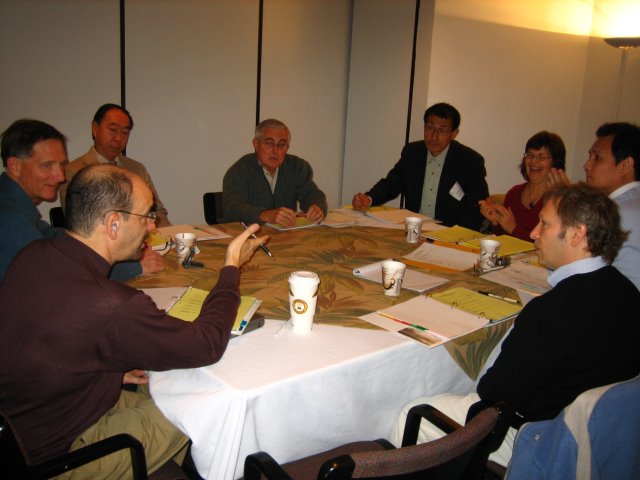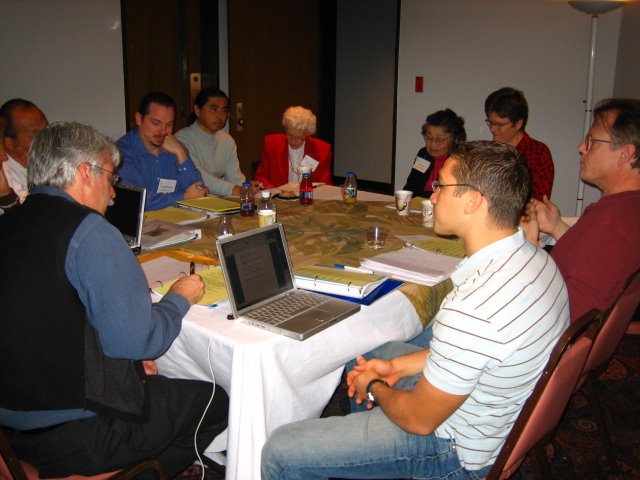Tai Chi and Seniors
In November, 2005 World Tai Chi & Qigong Day met with nearly 20 Tai Chi masters and teachers, medical researchers and national
administrators such as the National Council for the Aging and YMCA's of America, to explore ways to catapult Tai Chi and Qigong into
the mainstream of America within the next two to five years. The goal is to jump from the 1% or 2% of the population now estimated to
be using and benefitting from Tai Chi & Qigong practice to at least 25% of the US population.
This historic event came together due to the efforts of acclaimed Qigong author and former NQA President, Roger Jahnke.
Details from this national strategy session will be available to anyone and everyone, with no restrictions on use or reprinting of the program.
The initial release of the findings of this meeting will be released at the end of December 2005, and will be made available through
www.worldtaichiday.org to Tai Chi & Qigong groups and teachers worldwide in the hopes that similar efforts will be begun in other nations
worldwide as this pioneering US effort unfolds.
World Tai Chi & Qigong Day's focus at this expert meeting and national program development was to encourage the mass
distribution of Tai Chi & Qigong nationally, in a way that would recognize and support the value of Tai Chi & Qigong teachers
and masters now teaching across the nation. The national plan being developed is designed, not to replace existing teachers and masters,
but to rather interest millions more in Tai Chi & Qigong with mass introductory "tastes" of Tai Chi & Qigong.
This effort will create
abundance and recognition for long time teachers as millions who are now ignorant of Tai Chi & Qigong will be exposed to it through this
national program, and many of whom will seek more indepth instruction after being introduced to Tai Chi & Qigong by national programs.
World Tai Chi & Qigong Seniors
This Expert Meeting on Qi Gong/Tai Chi was hosted at the University of Illinois at Urbana-Champaign, and facilitated and coordinated in a brilliant fashion due to the efforts of several people within the Department of Kinesiology at the University.They included: Wojtek Chodzko-Zajko, Ph.D. Head of the Department of Kinesiology; Chae-Hee Park; Karl Rosengren; and Lisa Sheppard
- Department of Kinesiology at the University of Illinois, in conjunction with the National Council on the Aging, explore the opportunities, issues, and challenges of integrating Qi Gong and Tai Chi into the Aging Network nationally.
"i Gong and Tai Chi are ancient Chinese wellness practices (including martial arts, breath practices, self-applied massage, and meditation) that have been used throughout Asia for thousands of years as a means of promoting health and functional well-being. There is a growing awareness that Qi Gong and Tai Chi are excellent forms of exercise for older adults due to the low impact, low cost, and ease of performance.
The purpose of the expert meeting is to assemble experts in three areas:
1) Physical activity and the Aging Network;
2) Qi Gong/Tai Chi research; and
3) Qi Gong/Tai Chi practice to provide insight into the challenges of translating existing
research models into effective community-based programs.
Experts will discuss the issues of integrating elements of Qi Gong and Tai
Chi into physical activity programming, the feasibility of training "lay
leaders" in Chinese health enhancement arts programs, and implementation
and evaluation strategies.
Tai Chi Gaining Ground as Exercise for Elderly
The style, known as Tai Chi Fundamentals, combines the traditions of the Chinese practice along with modern therapeutic principles to form an exercise plan feasible for elderly adults with a range of health problems — from arthritis to heart disease. . . Long used in China as a way to promote wellness, Tai Chi focuses on building strength, balance and flexibility through slow, fluid movements combined with mental imagery and deep breathing. Studies have suggested that the elderly can reduce their risk of falls, lower their blood pressure and ease arthritis symptoms through the practice, and some research indicates Tai Chi can improve heart and blood vessel function in both healthy people and those with heart conditions.
"It's the regular practice of Tai Chi that makes it beneficial," Matsuda told Reuters Health. Making the practice accessible through a simplified style like TCF or through free classes at community senior centers, for example, should help older people stick with it.
Writing in the March issue of the Rehab Management Journal, Matsuda and her co-authors, including one of the developers of TCF, Tricia Yu, describe how various rehabilitation therapists in the U.S. are using the program to help older patients with chronic illnesses.
The exercise, according to the Matsuda and her colleagues, can be beneficial for a range of patients, including those who are recovering from total knee replacement or who have cardiovascular or lung conditions, given that instructors are properly trained in the needs of elderly adults with health limitations.
more at: http://abcnews.go.com/Health/wireStory?id=626251
EXERCISE HELPS REDUCE ALZHEIMERS ONSET
Sangram Sisoda, the Director of the U of C Molecular Biology Center says "Anything that keeps the mind active is going to be healthful. The mind-body connection is a very important one. The brain can be restructured simply by increasing physical activity." Bill Thies, Vice President of Scientific Affairs for the Alzheimers Assn. agrees and continues, " . . . inactivity is going to become more of a consideration . . . kids are playing (video games), watching TV, eating hamburgers, and not doing exercise."
The findings of the study indicate that environment can alter the molecular function of the brain. " . . . A more engaging enriched life (which includes learning and physical activity) may reduce the progression of Alzheimers Disease." according to S. Karsten and D. Geschwind of UCLA, in an accompanying editorial.
RHEUMATIC DISEASES, OSTEOARTHRITIS, MUSCULOSKELETAL CONDITIONS (FIBROMYALGIA), MULTIPLE SCLEROSIS & TAI CHI:
[Excerpt from the Arthritis Foundation's ARTHRITIS TODAY Publication]
With slow movements as fluid as silk, the gentle Chinese practice of Tai Chi seems tailor-made for easing sore joints and muscles . . . Doctors recommend tai chi for people with a variety of musculoskeletal conditions because it improves flexibility and builds muscle strength gradually. "There's no doubt that tai chi, done properly, can be a beneficial exercise for people with arthritis,"says Paul Lam, MD, a Sydney-based family practitioner and tai chi master who designed the Australian arthritis program.
Martin Lee, a tai chi authority and author of many books who has directed classes for years, says he has seen many people's overall health improve as they do tai chi. "Tai chi relieves stress,"he says. "It can be very healing."
Tai chi is an exercise almost anyone who can walk can do safely, says Dr. Lam, who began doing tai chi nearly 30 years ago for his own osteoarthritis. Tai chi takes the joints gently through their range of motion, he says, while the emphasis on breathing and inner stillness relieves stress and anxiety. Classes are inexpensive, and it can be practiced almost anywhere at any time, with no special equipment or clothing.
Peter Stein, MD, a Greenbrae, Calif., rheumatologist, says he finds tai chi especially good for people with fibromyalgia and those with a high level of muscle pain. "People in pain often can't even do yoga,"he says. "They need something milder and more soothing, and tai chi is very good for relieving pain."
. . . some physicians who treat the elderly or those with musculoskeletal conditions such as arthritis have been impressed by how tai chi improves pain, range of motion and physical balance.
What the Science Says:
Several studies have shown that regular tai chi practice has benefits: It can reduce falls in the elderly or those with balance disorders — sometimes dramatically. In one 1996 Atlanta study, elderly people who practiced tai chi for 15 weeks reduced their risk of multiple falls by 47.5 percent. Falls are a particular danger for elders and others with brittle bones, or osteoporosis. For such people, falls frequently result in broken bones.
Research has shown tai chi has other benefits, too. Participants in the Atlanta study also had lower blood pressure at the end of the study; and a 1999 study that looked at people with multiple sclerosis who practiced tai chi found that it contributed to an overall improvement in quality of life for people with chronic, disabling conditions . . . a study from 1991 that evaluates its safety for rheumatoid arthritis patients. It concluded that 10 weeks of tai chi classes did not make joint problems worse, and says the weight-bearing aspects of this exercise has the potential to stimulate bone growth and strengthen connective tissue.
And a recent University of Arizona opinion paper on mind-body alternatives, such as tai chi and meditation, for rheumatic diseases concluded that stress and pain are closely related, and therapies that focus on psychological as well as physical function could be beneficial, when used along with conventional medications . . .
"Given its low impact and evidence that it tends to increase muscle strength and balance and give general pain relief, we think it's a worthwhile option for arthritis patients,"says William L. Haskell, PhD, deputy director of the Stanford [University] Center for Research in Disease Prevention in California.
Stanford has offered tai chi classes for years, and is launching a major National Institute on Aging study to assess benefits of various types of exercise on healthy aging. A year-long study of tai chi for those 60 and older is part of the project. While this study won't look at arthritis specifically, the data is expected to
provide evidence of tai chi's general benefits.
